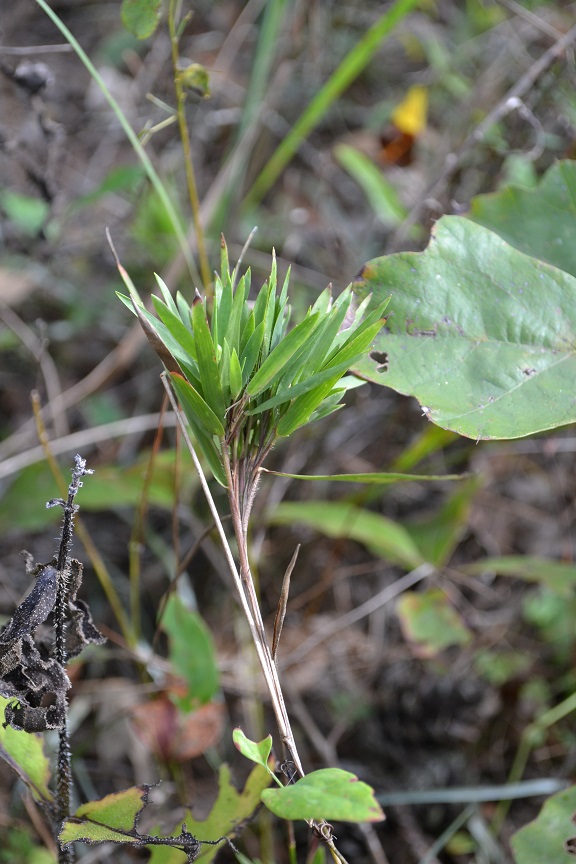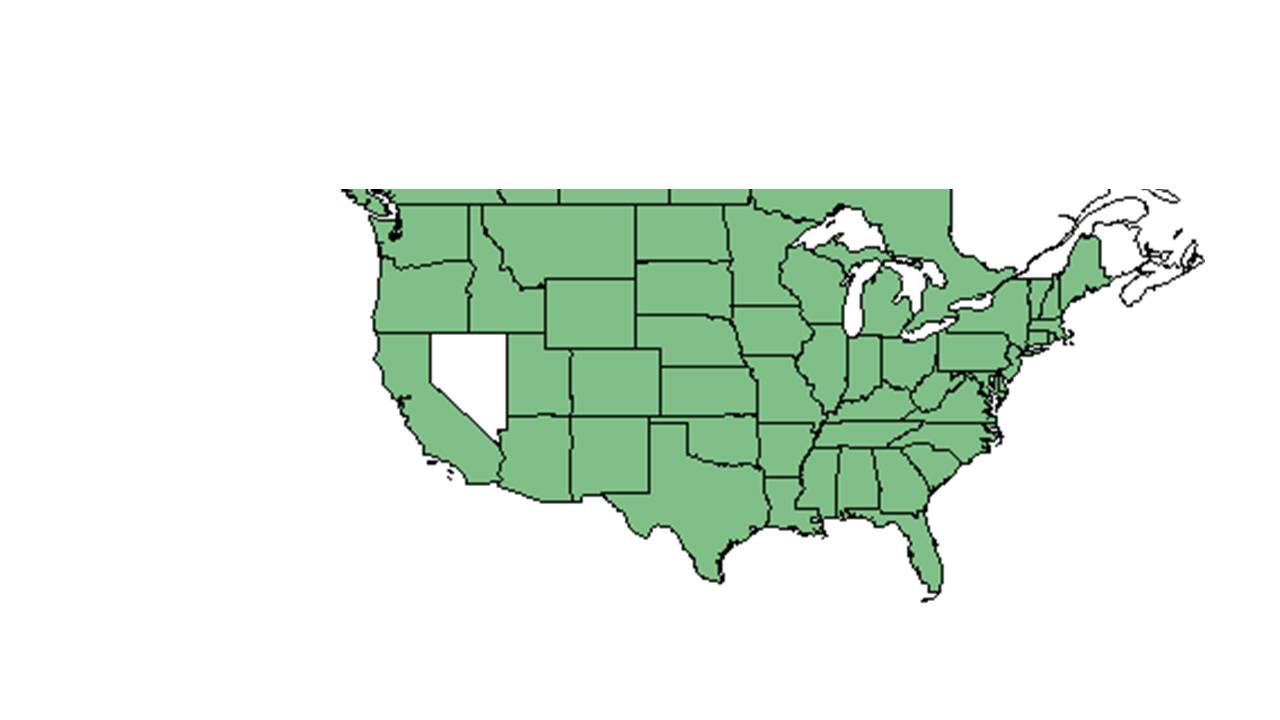Dichanthelium oligosanthes
| Dichanthelium oligosanthes | |
|---|---|

| |
| Photo taken by Kevin Robertson | |
| Scientific classification | |
| Kingdom: | Plantae |
| Division: | Magnoliophyta - Flowering plants |
| Class: | Liliopsida – Monocotyledons |
| Order: | Poales |
| Family: | Poaceae ⁄ Gramineae |
| Genus: | Dichanthelium |
| Species: | D. oligosanthes |
| Binomial name | |
| Dichanthelium oligosanthes (Schult.) Gould | |

| |
| Natural range of Dichanthelium oligosanthes from USDA NRCS Plants Database. | |
Common names: Heller's rosette grass, Heller's witchgrass, few-flowered witchgrass, Scribner's witchgrass
Contents
Taxonomic notes
Synonyms: Panicum oligosanthes J.A. Schultes; P. oligosanthes var. oligosanthes; P. oligosanthes var. scribnerianum (Nash) Fernald; P. scribnerianum Nash.[1]
Variety: Dichanthelium oligosanthes (J.A. Schultes) Gould var. oligosanthes; Dichanthelium oligosanthes (J.A. Schultes) Gould var. scribnerianum (Nash) Gould[1]
Description
Dichanthelium oligosanthes is a perennial graminoid. It tends to form dense tussocks of many stems. [2]
Generally, for the Dichanthelium genus, they have "spikelets usually in panicles, round or nearly so in cross section, 2-flowered, terminal fertile, basal sterile, neutral or staminate. First glume usually present, 2nd glume and sterile lemma similar; fertile lemma and palea indurate without hyaline margins. Taxonomically our most difficult and least understood genus of grasses, more than 100 species an varieties are ascribed to the Carolinas by some authors. Note general descriptions for species groups (e.g., 1-4, 5-8, 9-13, and 26-62)." [3]
Specifically, for the D. oligosanthes species, they are "perennial with distinct basal rosettes; branching, when present, from nodes above basal rosette. Leaves basal and cauline, vernal and autumnal. Culms 3-5 dm tall, nodes puberulent or pilose, not densely bearded, internodes puberulent or pilose. Blades to 10 cm long, 5-10 mm wide, glabrous on both surfaces or puberulent below, margins scaberulous, bases slightly cordate, ciliate; sheaths appressed or spreading pubescent; ligules densely ciliate, 3 mm long. Panicle 4-10 cm long, 3-8 cm broad; rachis puberulent or scaberulous, branches ascending to spreading, scaberulous or puberulent. Spikelets 3.5-4 mm long, obovoid to broadly ellipsoid; pedicles scaberulous. First glume scarious, glabrous or pubescent, acute, 1.5-2.2 mm long, 2nd glume and sterile lemma glabrous or sparsely pubescent, obtuse, 3-4 mm long; fertile lemma and palea 3-3.2 mm long. Grain 1-1.5 mm long, yellowish or purplish, broadly ellipsoid or subglobose." [3]
Distribution
Ecology
Habitat
It can live in Foard and Lawton soils, which are both grassland soils.[4] D. oligosanthes var. scribnerianum can tolerate hot summers, cold winters, minimal precipitation (826 mm per year), and moderately strong surface winds.[5] It seems to prefer light levels between open sun and partial shade. [2]
This species can be found in undisturbed areas.[6] It is commonly found in open woodlands[7] and tallgrass prairies.[5] D. oligosanthes also occurs in oak-pine flats, limestone glades, sand plains, loblolly pine forests, upland pine woods, and oak hammocks. [2] However, it can also be found in disturbed habitat like cut over pine woods, cultivated and old fields, roadsides, railways, and disturbed prairies. [2]
Associated species include Rudebeckia triloba, Panicum virgatum, Andropogon scoparius, Koeleria macrantha, Ambrosia psilostachya. [2]
Dichanthelium oligosanthes var. oligosanthes is an indicator species for the North Florida Longleaf Woodlands community type as described in Carr et al. (2010).[8]
Phenology
It flowers from early to mid season.[9]
Flowering has been observed in May, while fruiting has been observed in March, May, and June. [2]
Seed dispersal
Fire seems to stimulate the seed bank.[7]
Seed bank and germination
This species is thought to be dispersed by gravity. [10]
Fire ecology
D. oligosanthes responds positively to fire as it increased in distribution and abundance following an early dormant-season fire.[7] Dichanthelium oligosanthes var. scribnerianum found in uplands and lowlands responded positively to summer burns but negatively to spring burns in the long run (more than 10 years). However, D. oligosanthes found in the canopy cover declined with both burns.[5] Populations have been known to persist through repeated annual burns.[11]
Conservation, cultivation, and restoration
Cultural use
Photo Gallery
References and notes
- ↑ 1.0 1.1 Weakley, A.S. 2020. Flora of the Southeastern United States. Edition of 20 October 2020. University of North Carolina at Chapel Hill, Chapel Hill, North Carolina.
- ↑ 2.0 2.1 2.2 2.3 2.4 2.5 Florida State University Robert K. Godfrey Herbarium database. URL: http://herbarium.bio.fsu.edu. Last accessed: June 2014. Collectors: L.C. Anderson, Wilson Baker, R. Kral, M. Nee, E. D. Cappel, Riedeman, H. L. Blomquist, Harry E. Ahles, D. S. Correll, Duane Isely, S L Welsh, Dwight Isely, S. W. Leonard, A. E. Radford, H. R. Reed, T. MacClendon, K. MacClendon, Robert F. Thorne, James R. Burkhalter, R.K. Godfrey, Kurz, A. H. Curtiss, A. P. Anderson, Pat Howell, Brenda Thomas, George Wilder, F. Lyle Wynd, C. H. Mueller, Robert L. Lazor, and Raymond Athey. States and Counties: Florida: Calhoun, Duval, Escambia, Gadsden, Franklin, Jackson, Jefferson, Leon, Liberty, Okaloosa, and Suwannee. Georgia: Seminole. Kentucky: Caldwell, Livingston, and Logan. Louisiana: Ouachita. Mississippi: Pearl River. North Carolina: Moore, Cumberland, and Pender. South Carolina: Orangeburg. Texas: Bexar, Freestone, Tarrant, and Van Zandt. Virginia: Giles. Wisconsin: Richland. Other Countries: Mexico
- ↑ 3.0 3.1 Radford, Albert E., Harry E. Ahles, and C. Ritchie Bell. Manual of the Vascular Flora of the Carolinas. 1964, 1968. The University of North Carolina Press. 142-154. Print.
- ↑ Leis, S. A., D. M. Engle, et al. (2005). "Effects of short- and long-term disturbance resulting from military maneuvers on vegetation and soils in a mixed prairie area." Environmental Management 36: 849-861.
- ↑ 5.0 5.1 5.2 Towne, E. G. and K. E. Kemp (2008). "Long-term response patterns of tallgrass prairie to frequent summer burning." Rangeland Ecology & Management 61: 509-520.
- ↑ Jutila, H. M. and J. B. Grace (2002). "Effects of disturbance on germination and seedling establishment in a coastal prairie grassland: a test of the competitive release hypothesis." Journal of Ecology 90: 291-302; Towne, E. G. and K. E. Kemp (2008). "Long-term response patterns of tallgrass prairie to frequent summer burning." Rangeland Ecology & Management 61: 509-520.
- ↑ 7.0 7.1 7.2 Taft, J. B. (2003). "Fire effects on community structure, composition, and diversity in a dry sandstone barrens." Journal of the Torrey Botanical Society 130: 170-192.
- ↑ Carr, S.C., K.M. Robertson, and R.K. Peet. 2010. A vegetation classification of fire-dependent pinelands of Florida. Castanea 75:153-189.
- ↑ Pavlovic, N. B., S. A. Leicht-Young, et al. (2011). "Short-term effects of burn season on flowering phenology of savanna plants." Plant Ecology 212: 611-625.
- ↑ Kirkman, L. Katherine. Unpublished database of seed dispersal mode of plants found in Coastal Plain longleaf pine-grasslands of the Jones Ecological Research Center, Georgia.
- ↑ Robertson, K.M. Unpublished data collected from Pebble Hill Fire Plots, Pebble Hill Plantation, Thomasville, Georgia.
